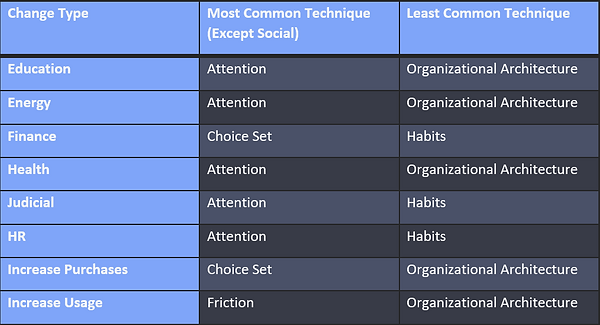Behavioral Teams Change Techniques
Reviewing the techniques which behavioral science teams tend to use across sector, industry, and change type.
Main Findings
-
Social Techniques are the most commonly used while Habit formation techniques are the least.
-
Governments frequently use Social, Friction, and Attention techniques.
-
HR related groups tend to focus on organizational architecture, suggesting there is an opportunity for growth into new techniques.
Sector
We used our standard sector metrics which includes For-Profit Companies, Non-Profit Company, Consulting Companies, Government Entity, and Academic Units.
What immediately stood out was Social Norms which were the most popular technique for every sector. Robert Cialdini published his book Influence almost 40 years ago indicating the concept of using social techniques to change behavioral has been around for a while and can be seen in its widespread usage. On the opposite side of the spectrum, Organizational Architecture was the least selected with all the groups except for Government Entities. This is likely partially due to the loosely defined nature of the subject along with the specialized skill set to do it on a scale.
Looking at for-profit companies, more than half of the responses suggested that they use friction such as defaults and attention-grabbing devices such as reminders. Which likely shows the tools that are used to capture and keep the user’s attention on their products. Consulting companies shared the same high level of responses for those two plus the use of choice-setting devices. Non-profits had lower levels of responses across the board but seemed to use attention techniques the most beyond social norms.
Academic groups had the highest reporting of habit creating techniques with over half of responders suggesting usage. Government groups along with the academic units both seemed to use incentives much more than the other sectors. For the former this makes sense through tax incentives and the sort.

Change Type
The survey allowed for a multi-selection of change types and had eight types of responses which an individual could choose: Education & learning; Energy use & environmental behavior; Finance (spending, saving, investing); Health & health care (healthy eating, medication adherence, etc.); Judicial, legal, or regulatory compliance; Organizational change or human resources; Purchase of a product or service; Usage of a product or service.
Again, we found that the most popular across the change types was Social Norms. Similarly, we found of the eight change types that Organizational Architecture was also the lowest rated by five types. Habits were rated the lowest by Judicial, Organizational Change, and Financial. This came as a surprise and indicated an opportunity for these sectors to build further resources to develop habits, especially in the financial sector. Beyond this, the groups had little variance in responses for the remaining techniques. Attention and Choice Setting techniques appear to have high popularity with Incentives having the opposite.

Location in Unit
Survey respondents who selected they were a part of a for-profit, non-profit, or consulting company were asked where their unit was located. This led to a smaller sample size but still some interesting findings. Location options included: Product; Design; Data Science / Business Analytics / Research; Marketing; Human Resources or People Analytics; External Consulting; Other Internal Consulting
For this analysis, the trends of social norms being most selected and organizational architecture being least still held true but much less. Human Resources broke the trend most significantly, indicating that organizational architecture was the most popular technique and incentives were the least selected. Given the responsibilities of the HR departments, these results support what intuition would suggest. Product and Design teams both indicated that their top choice was Attention seeking techniques which is seen through the proliferation of push notification and other prompts (or distractions).

Success of Techiques
At the aggregate, the most successful technique was the development of habits. Reflecting that this is also the least used technique suggests that potentially more resources are required for this technique and thus has a higher rate of success. The least successful was social techniques. This was the most used so it may have the opposite effect of what was seen with habits techniques.
This work was completed by ABSA Co-Founder and Exec Committee Member Connor Joyce. If you have any questions, comments, or suggestions please click here to message him.


